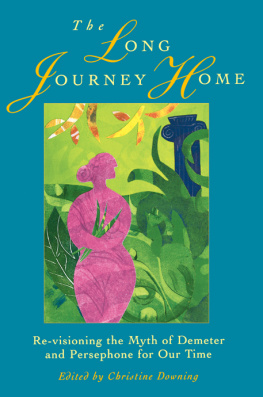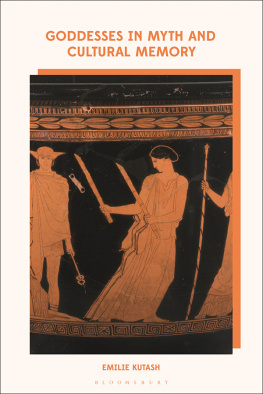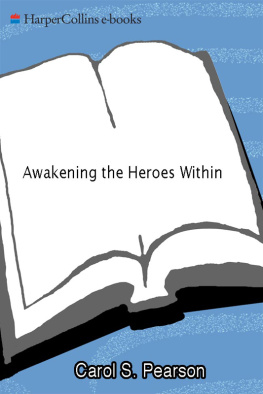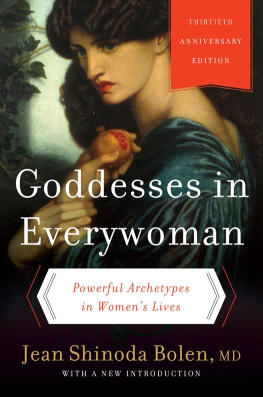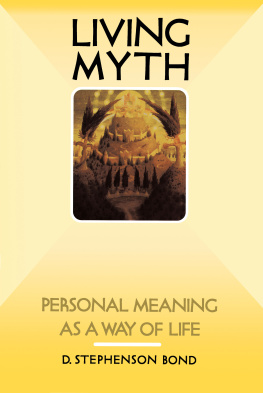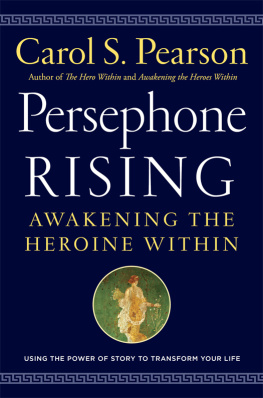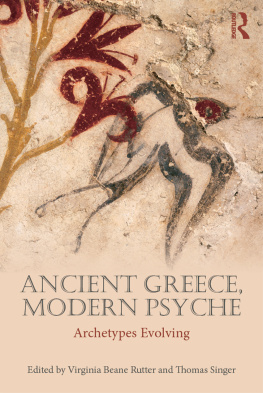ABOUT THE BOOK
The story of the mother-and-daughter goddesses Demeter and Persephone has seized the imagination of people in every age, from ancient times to the present. Considered today by many to be the archetypal myth for women, it touches on timeless themes in every life, such as the male-female relationship, love between women, initiations into puberty and old age, the mother-daughter bond, death, and ecological renewal. Christine Downing has combined essays, prose, poetry, and even performance art with her own insightful commentary to shed new light on the myths ancient meanings and to offer new insights in its implications for contemporary men and women.
CHRISTINE DOWNING, Ph.D., is the author of numerous books, including The Goddess, Psyches Sisters, Myths and Mysteries of Same-Sex Love, and Mirrors of the Self.
Sign up to learn more about our books and receive special offers from Shambhala Publications.

Or visit us online to sign up at shambhala.com/eshambhala.
THE
LONG JOURNEY HOME

RE-VISIONING THE MYTH OF DEMETER AND PERSEPHONE FOR OUR TIME

EDITED BY
Christine Downing

SHAMBHALA
Boston & London
2013
SHAMBHALA PUBLICATIONS, INC.
Horticultural Hall
300 Massachusetts Avenue
Boston, Massachusetts 02115
www.shambhala.com
1994 by Christine Downing
Cover art by Roberta Arenson
The page constitutes a continuation of the copyright page.
All rights reserved. No part of this book may be reproduced in any form or by any means, electronic or mechanical, including photocopying, recording, or by any information storage and retrieval system, without permission in writing from the publisher.
LIBRARY OF CONGRESS CATALOGING-IN-PUBLICATION DATA
The Long journey home: re-visioning the myth of Demeter and Persephone for our time/[edited by] Christine Downing.1st ed.
p. cm.
Includes bibliographical references.
eISBN 978-0-8348-2888-9
ISBN 1-57062-685-5 (pbk.: alk. paper)
1. Demeter (Greek deity). 2. Persephone (Greek deity). 3. Mythology, GreekPsychological aspects. 4. Mothers and daughters. 5. WomenPsychology. I. Downing, Christine, 1931
BL820.C5L66 1994
93-39134
292.13dc20
CIP
BVG 01
Dedicated to Carol P. Christ,
who blessed
my first written reflections
on Persephone
in a way that has nurtured
all my subsequent writing
CONTENTS

translated by David G. Rice and John E. Stambaugh
translated by Mary Innes
Erich Neumann
H. D.
Meridel Le Sueur
Charlene Spretnak
Herta Rosenblatt
Alma Luz Villanueva
Carol P. Christ
Christine Downing
Annis Pratt
River Malcolm
Bruce Lincoln
Vera Bushe
Helen Luke
Patricia Berry
Polly Young-Eisendrath
Christine Downing
Christine Downing
Naomi R. Goldenberg
John Daughters
Gloria Feman Orenstein
Laura Simms

I WOULD LIKE to thank Charles Ascher and Jonathan Young of Pacifica Graduate Institute for the invitation to lecture on paths to the power of myth, which first suggested to me the appropriateness of gathering together recent reinterpretations and revisionings of the myth of Demeter and Persephone.
The enthusiasm of Karen Brown, William Doty, and David L. Miller for this project helped me decide to go forward with it. River Malcolms sense of its importance has sustained me throughout the months devoted to its completion.
I would also like to thank the many contributors to this volume who agreed to let me use their work and most especially those who wrote essays specifically for inclusion here: Carol Christ, Naomi Goldenberg, Gloria Orenstein, Annis Pratt, and Laura Simms.
I feel a special debt and want publicly to express an apology to some writers who had graciously agreed to the inclusion of essays that my publishers sense of the appropriate length for this volume forced me to exclude: Phyllis Chesler, Genia Pauli-Haddon, Mara Lynn Keller, and Betty DeShong Meador. Some indication of their understanding of the myth and the rituals associated with it is given in the introductions to the various subsections of this book. The list of further readings at the end of the volume provides the bibliographic material that will enable readers to find these materials. This list also includes materials by Jane Harrison, C. G. Jung, and Carl Kerenyi that I had planned to include and had received permission to use but reluctantly agreed to leave out.
David Cohen came to my rescue when I was most devastated by the prospect of amputating my book by reminding me that I shouldnt have expected to put together a book about Persephone and Demeter without having to spend a few days in the underworld.
Once again Elaine Rother has helped me immeasurably: she has typed and retyped, made innumerable telephone calls, and prepared the many different versions of the manuscripts for mailing; she has celebrated with me when things have gone well and commiserated when they have not. I cannot imagine how, now that I have retired from San Diego State University and will soon move to the Northwest, I will manage to put a book together without her help. I also want to thank Kim Berling for her careful photocopying of the previously published material included in the volume and of many other relevant materials not included.
I want to thank Jonathan Green for encouraging me to submit a book proposal to Shambhala Publications and Emily Hilburn Sell for her editorial supervision of the project.
I dedicated my first book, The Goddess: Mythological Images of the Feminine, to my mother and my daughter. This book, too, emerges out of my sense of how much I owe to both and how deeply I love them.

I HAVE LONG BEEN fascinated by the sacred myths and rituals of initiation through which women and men of the ancient world were helped to discover and become themselves. I have long believed that remembering and reimagining these traditions might help us do likewise. Like James Hillman, I believe that although myths dont tell us how, they help us to question, imagine, go deeper. Myths help us to enter the complexity of our situations more deeply, with more love of the perplexities themselves and of those caught up in them.
The myth of Demeter and Persephone stirs the imagination of almost all who hear it. Greek rituals associated with it recognized its relevance to the cycle of vegetal life, to the human fear of death and hope for immortality, to the deep bonds that exist among women, particularly mothers and daughters. Some of these rituals were open only to women, others also included men. The myth appears to have particular resonance for women, and many seem to feel that in some sense it is
Next page
